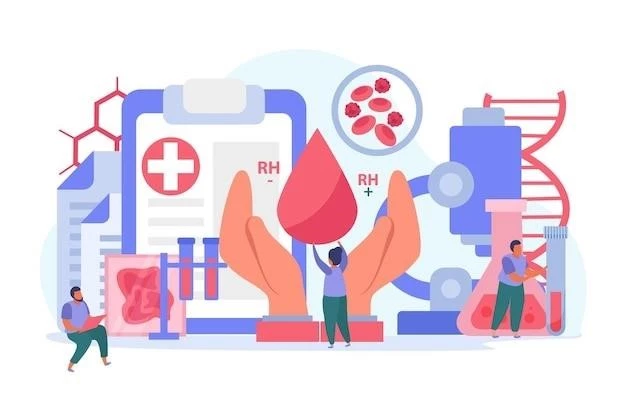Giant platelet syndrome, also known as enlarged platelet disorder, is a rare inherited condition characterized by macrothrombocytopenia, where individuals have abnormally large platelets. This disorder can lead to a bleeding tendency due to abnormal platelet shape and function.
Introduction
Individuals with giant platelet syndrome, also known as enlarged platelet disorder, experience thrombocytopenia, meaning they have a lower than normal platelet count. This condition is often inherited and can result in a bleeding tendency due to the altered platelet function and shape.
Macrothrombocytopenia, where platelets are larger than usual, is a hallmark of this syndrome. The platelet count in affected individuals may be normal, but the platelets themselves are abnormally big. This can impact how the platelets function, affecting blood clotting mechanisms.
One specific type of giant platelet syndrome is Bernard-Soulier syndrome, where there is a deficiency in certain platelet adhesion molecules. Without these molecules, platelets struggle to stick together and form clots effectively, leading to prolonged bleeding episodes and an increased risk of hemorrhaging.
Diagnosing giant platelet syndrome involves blood tests to check the platelet count, function, and shape. Genetic testing may also be done to identify the specific mutation causing the disorder. Understanding the underlying genetic mutations is crucial for determining the appropriate medical treatment.
Treatment options for giant platelet syndrome focus on managing the bleeding tendencies associated with the condition. This may involve medications to help the blood clot more effectively or platelet transfusions to increase the platelet count in severe cases. Regular monitoring and medical interventions can help individuals with this rare disorder live healthier lives.
Giant platelet syndrome, characterized by macrothrombocytopenia, is a rare inherited condition that affects the platelets – the blood cells responsible for clotting. In individuals with this disorder, the platelets are notably larger than normal, impacting their function and leading to a tendency for abnormal bleeding.
Platelets play a crucial role in the blood clotting process. When there is an injury, platelets rush to the site to form a clot and stop the bleeding. However, in giant platelet syndrome, the abnormally large platelets may not be as effective in forming clots, leading to bleeding episodes.
Bernard-Soulier syndrome, a specific type of giant platelet disorder, is characterized by a deficiency in the adhesion molecules that help platelets stick together. This deficiency impairs the platelets’ ability to clump and form clots efficiently, resulting in a higher risk of bleeding.
Genetic mutations play a significant role in giant platelet syndrome. These mutations affect the production or function of proteins involved in platelet formation and function. Understanding these genetic alterations is crucial for diagnosing the condition and developing targeted treatment strategies.
Individuals with giant platelet syndrome may experience a range of symptoms, including easy bruising, nosebleeds, and prolonged bleeding following injuries or dental procedures. Diagnosing the condition involves blood tests to assess the platelet count, function, and shape, as well as genetic testing to identify the specific mutation.
Medical management of giant platelet syndrome focuses on addressing the bleeding tendencies associated with the disorder. This may involve medications to improve blood clotting, platelet transfusions in severe cases, and close monitoring to prevent complications related to excessive bleeding.
Platelet Function in Giant Platelet Syndrome

In giant platelet syndrome, the abnormally large platelets impact the crucial function of these blood cells in the clotting process. Platelets are essential for hemostasis, the body’s mechanism for preventing and stopping bleeding. However, in individuals with giant platelet syndrome, the altered platelet shape and size can hinder their ability to effectively form clots.
One key aspect of platelets’ function is adhesion, where platelets stick to the damaged blood vessel wall to initiate clot formation. The adhesion molecules on the platelet’s surface play a vital role in this process. In conditions like Bernard-Soulier syndrome, the deficiency of these adhesion molecules impairs the platelet’s ability to adhere to the damaged vessel wall, leading to difficulties in forming clots.
Another essential function of platelets is aggregation, where platelets clump together to form a plug at the site of injury. In giant platelet syndrome, the abnormally large platelets may have reduced aggregation ability, affecting their ability to form stable blood clots. This impaired aggregation can result in prolonged bleeding times and an increased risk of hemorrhaging.
Platelets also release proteins known as clotting factors, which help strengthen and stabilize the formed clot. In giant platelet syndrome, the altered platelet function may impact the release of these clotting factors, further contributing to difficulties in achieving proper clot formation.
Understanding the specific abnormalities in platelet function in giant platelet syndrome is crucial for both diagnosis and treatment. Blood tests that assess platelet function, such as platelet aggregation studies, can provide valuable insights into how well the platelets are functioning and help guide medical interventions to address the bleeding tendencies associated with the condition.
Causes and Diagnosis
Enlarged platelet disorder, also known as giant platelet syndrome, is primarily caused by genetic mutations that affect the production or function of proteins involved in platelet formation and function. These mutations can lead to macrothrombocytopenia, where individuals have abnormally large platelets (macrothrombocytes) and a decreased platelet count (thrombocytopenia).
Diagnosing giant platelet syndrome involves a thorough evaluation that includes assessing the patient’s medical history, symptoms, and performing various blood tests. A complete blood count (CBC) is crucial for measuring the platelet count and identifying any abnormalities in their size and shape.
Platelet function tests are also essential for diagnosing giant platelet syndrome. These tests evaluate how well the platelets in the blood are functioning, including their ability to clot properly. Platelet aggregation studies can help determine if the platelets aggregate efficiently in response to certain substances.
Genetic testing plays a significant role in confirming the diagnosis of giant platelet syndrome. By identifying the specific genetic mutation responsible for the disorder, healthcare providers can better understand the underlying cause and tailor treatment strategies accordingly.
In addition to genetic testing, bone marrow examinations may be recommended in some cases to assess the production of blood cells, including platelets. Examining the bone marrow can provide insights into any abnormalities in platelet production and help rule out other potential causes of thrombocytopenia.
Early and accurate diagnosis of giant platelet syndrome is essential for effectively managing the condition and preventing complications associated with abnormal platelet function and bleeding tendencies; By identifying the specific causes of the disorder, healthcare providers can develop personalized treatment plans to address the unique needs of each individual affected by this rare inherited condition.
Symptoms and Complications
Individuals with giant platelet syndrome may experience a range of symptoms related to abnormal platelet function and the resulting bleeding tendencies. Common symptoms include easy bruising, nosebleeds, and prolonged bleeding following injuries or medical procedures. These symptoms can vary in severity from mild to more significant bleeding episodes.
Due to the impaired ability of the abnormally large platelets to form clots efficiently, individuals with giant platelet syndrome are at an increased risk of hemorrhaging. Bleeding episodes may occur spontaneously or after minor trauma, surgeries, or dental work. Excessive or prolonged bleeding can lead to complications such as anemia and, in severe cases, may be life-threatening.
In Bernard-Soulier syndrome, a specific type of giant platelet disorder, the deficiency of platelet adhesion molecules further exacerbates the bleeding tendency. This deficiency impairs the platelets’ ability to adhere to damaged blood vessel walls, leading to difficulties in clot formation and an increased risk of bleeding complications.
Complications of giant platelet syndrome can include chronic anemia due to recurrent bleeding episodes, which may require medical intervention such as iron supplementation or blood transfusions. Additionally, prolonged or severe bleeding can impact an individual’s quality of life, leading to physical and emotional distress.
Regular monitoring and early detection of symptoms are crucial in managing giant platelet syndrome and preventing complications. Healthcare providers may recommend preventive measures, such as avoiding activities that increase the risk of injury, and educating patients and their families on signs of potential bleeding episodes.
Overall, recognizing the symptoms and potential complications of giant platelet syndrome is essential for prompt medical intervention and management of the condition. By effectively addressing the bleeding tendencies associated with this rare disorder, healthcare providers can improve the quality of life and outcomes for individuals affected by giant platelet syndrome.
Treatment Options
Medical treatment for giant platelet syndrome focuses on managing the bleeding tendencies associated with the condition. The specific treatment approach may vary depending on the severity of symptoms and the individual’s overall health. Treatment options aim to prevent and control bleeding episodes by supporting proper blood clotting mechanisms.
One common treatment for giant platelet syndrome is the administration of medications that help improve blood clotting. These medications may include desmopressin, which stimulates the release of von Willebrand factor and enhances platelet function. Other medications, such as antifibrinolytic agents, work by stabilizing blood clots and reducing bleeding.
In cases where the platelet count is significantly low or the bleeding is severe, platelet transfusions may be necessary. Platelet transfusions can quickly increase the platelet count in the blood, aiding in clot formation and controlling bleeding episodes. Transfusions are typically reserved for acute situations or when bleeding is excessive.
For individuals with Bernard-Soulier syndrome, specific treatment strategies may include the administration of ristocetin—an antibiotic that can improve platelet function by enhancing platelet aggregation. Additionally, healthcare providers may recommend regular monitoring of platelet counts and function to assess the effectiveness of treatment interventions.
Preventive measures are also essential in managing giant platelet syndrome. Patients are advised to take precautions to avoid injuries that may lead to bleeding episodes. This includes wearing protective gear during physical activities and informing healthcare providers about their condition before undergoing surgical procedures.
Regular follow-up appointments with healthcare providers are crucial for monitoring the effectiveness of treatment and managing any complications that may arise. Through a multidisciplinary approach involving hematologists, genetic counselors, and other specialists, individuals with giant platelet syndrome can receive comprehensive care tailored to their specific needs.
By combining medical interventions with lifestyle modifications and ongoing support, individuals with giant platelet syndrome can effectively manage their condition and minimize the impact of bleeding tendencies on their daily lives. With advancements in treatment options and personalized care plans, the outlook for individuals with giant platelet syndrome continues to improve.
